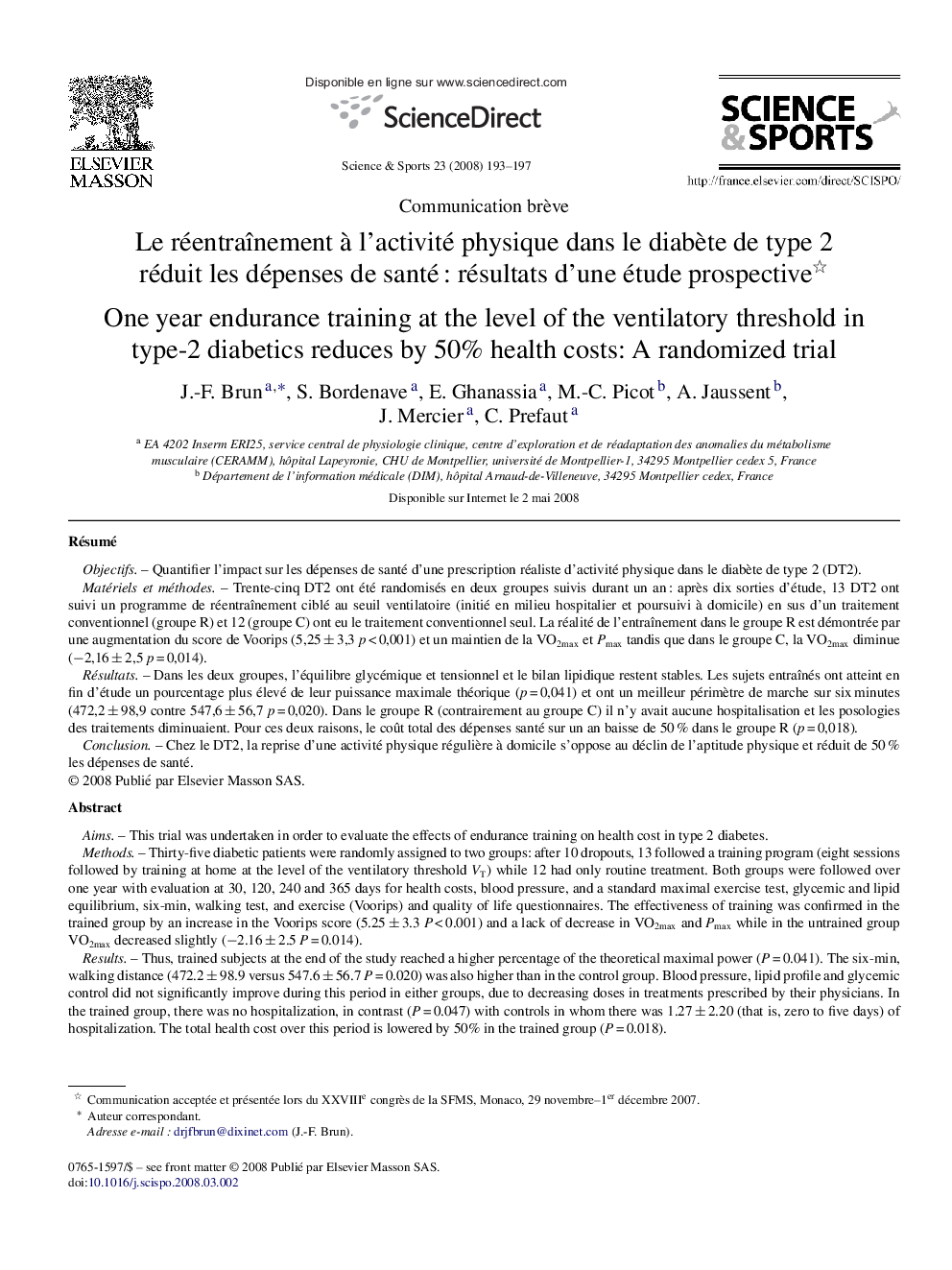| کد مقاله | کد نشریه | سال انتشار | مقاله انگلیسی | نسخه تمام متن |
|---|---|---|---|---|
| 4093215 | 1605036 | 2008 | 5 صفحه PDF | دانلود رایگان |

RésuméObjectifsQuantifier l’impact sur les dépenses de santé d’une prescription réaliste d’activité physique dans le diabète de type 2 (DT2).Matériels et méthodesTrente-cinq DT2 ont été randomisés en deux groupes suivis durant un an : après dix sorties d’étude, 13 DT2 ont suivi un programme de réentraînement ciblé au seuil ventilatoire (initié en milieu hospitalier et poursuivi à domicile) en sus d’un traitement conventionnel (groupe R) et 12 (groupe C) ont eu le traitement conventionnel seul. La réalité de l’entraînement dans le groupe R est démontrée par une augmentation du score de Voorips (5,25 ± 3,3 p < 0,001) et un maintien de la VO2maxVO2max et Pmax tandis que dans le groupe C, la VO2maxVO2max diminue (−2,16 ± 2,5 p = 0,014).RésultatsDans les deux groupes, l’équilibre glycémique et tensionnel et le bilan lipidique restent stables. Les sujets entraînés ont atteint en fin d’étude un pourcentage plus élevé de leur puissance maximale théorique (p = 0,041) et ont un meilleur périmètre de marche sur six minutes (472,2 ± 98,9 contre 547,6 ± 56,7 p = 0,020). Dans le groupe R (contrairement au groupe C) il n’y avait aucune hospitalisation et les posologies des traitements diminuaient. Pour ces deux raisons, le coût total des dépenses santé sur un an baisse de 50 % dans le groupe R (p = 0,018).ConclusionChez le DT2, la reprise d’une activité physique régulière à domicile s’oppose au déclin de l’aptitude physique et réduit de 50 % les dépenses de santé.
AimsThis trial was undertaken in order to evaluate the effects of endurance training on health cost in type 2 diabetes.MethodsThirty-five diabetic patients were randomly assigned to two groups: after 10 dropouts, 13 followed a training program (eight sessions followed by training at home at the level of the ventilatory threshold VT) while 12 had only routine treatment. Both groups were followed over one year with evaluation at 30, 120, 240 and 365 days for health costs, blood pressure, and a standard maximal exercise test, glycemic and lipid equilibrium, six-min, walking test, and exercise (Voorips) and quality of life questionnaires. The effectiveness of training was confirmed in the trained group by an increase in the Voorips score (5.25 ± 3.3 P < 0.001) and a lack of decrease in VO2maxVO2max and Pmax while in the untrained group VO2maxVO2max decreased slightly (−2.16 ± 2.5 P = 0.014).ResultsThus, trained subjects at the end of the study reached a higher percentage of the theoretical maximal power (P = 0.041). The six-min, walking distance (472.2 ± 98.9 versus 547.6 ± 56.7 P = 0.020) was also higher than in the control group. Blood pressure, lipid profile and glycemic control did not significantly improve during this period in either groups, due to decreasing doses in treatments prescribed by their physicians. In the trained group, there was no hospitalization, in contrast (P = 0.047) with controls in whom there was 1.27 ± 2.20 (that is, zero to five days) of hospitalization. The total health cost over this period is lowered by 50% in the trained group (P = 0.018).ConclusionEndurance training at the level of the VT significantly prevents the progressive decline in aerobic working capacity evidenced in untrained diabetics over this period of observation and markedly reduces health care costs, due to a decrease in treatment and fewer hospitalizations.
Journal: Science & Sports - Volume 23, Issues 3–4, June–August 2008, Pages 193–197